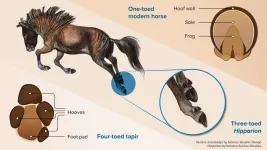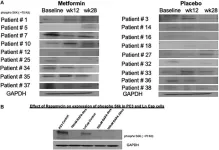(Press-News.org) The distant ancestors of modern horses had hooved toes instead of a single hoof, which vanished over time, according to researchers.
The animals, such as the Eocene Hyracotherium, had feet like those of a modern tapir: four toes in front and three behind, each individually hooved with an underlying foot pad.
In contrast, modern equids such as horses, asses, and zebras, have only a single toe, the left over original third toe on each foot, encased in a thick-walled keratinous hoof, with an underlying triangular frog on the sole that acts as a shock absorber.
An international team of scientists, from the UK, the US, and the Netherlands, analysed hoof prints and foot bones from modern horses and fossil records to discover what happened to the lost digits.
Author Professor Christine Janis from the University of Bristol’s School of Earth Sciences explained: “The upper portions – the remains of the additional hand and foot bones - remain as ‘splint bones’ fused with the remaining central one, but where are the fingers and toes?"
“In later fossil horses there were only three toes front and back. The extra toes, known as side toes, in these horses were smaller and shorter than in a tapir, and likely did not touch the ground under normal circumstances, but they may have provided support in exceptional situations, such as sliding or forceful impact.”
In findings, published today in Royal Society Open Science, they confirm the older notion that these toes really have been completely lost in evolution, not somehow retained within the hoof, as proposed in another recent paper published in the same journal in 2018.
Lead author Professor Alan Vincelette, of St. John’s Seminary, Camarillo, California pointed out: “Although it does seem that remainders of the proximal (upper portions) of the side digits have been retained in modern horses, as the earlier 2018 paper claimed, the distal (lower portions, or toes) have simply been lost.
The 2018 paper proposed that in modern horses these side toes are retained within the hoof of the central toe, in part contributing to the frog - although there are no actual bones within the frog.
This was partially based on an interpretation of the hoof prints of an extinct three-toed horse, Hipparion (not on the direct line to modern horses) from Laetoli in Tanzania 3.7 million years ago, the same site that yielded the famous foot prints of the hominid Australopithecus. These hoof prints apparently lacked a frog, and this added weight to the notion that the side toes of horses like Hipparion now contribute to the frog of modern horses.
While not all hoof prints of modern horses with frogs record its presence, an undoubted frog can be seen in many hoof prints that are known to have been made by three-toed horses. These observations cast doubt on the notion that the frog of modern horse hooves formed out of the side toes of tridactyl equids.
Author Professor Christine Janis from the University of Bristol’s School of Earth Sciences said: “While the notion that modern horses have retained all of their original toes as within-hoof remnants is a novel one, and so rather appealing, it can be shown to be incorrect.”
Alan Vincelette added: “The frog of the horse's hoof evolved independently of the side toes as a unique structure providing shock absorption and traction during locomotion.”
The team also show that the feet of one-toed horses have a different shape from the main toe of the foot of three-toed horses, being round rather than oval, a difference that may be related to differences in weight distribution and/or ecological habitat.
Paper:
‘Hipparion tracks and horses’ toes: the evolution of the equid single hoof’ by Alan Vincelette, Christine Janis et al. in Royal Society Open Science.
END
Modern horses have lost their additional toes, scientists confirm
2023-06-21
ELSE PRESS RELEASES FROM THIS DATE:
Scientists discover critical factors that determine the survival of airborne viruses
2023-06-21
Critical insights into why airborne viruses lose their infectivity have been uncovered by scientists at the University of Bristol. The findings, published in the Journal of the Royal Society Interface today [21 June], reveal how cleaner air kills the virus significantly quicker and why opening a window may be more important than originally thought. The research could shape future mitigation strategies for new viruses.
In the first study to measure differences in airborne stability of different variants of SARS-CoV-2 in inhalable particles, ...
UK's young people at risk of leaving school without vital knowledge of reproductive health, study finds
2023-06-21
Pupils in the UK are not learning about potentially life-changing issues such as endometriosis, infertility, and miscarriage, according to a new study of curricula in science and in relationships and sex education.
Researchers from University College London (UCL) looked at what schools are expected to teach 14–18-year-olds across the UK, using curriculum requirements and specifications set by exam boards. Findings, published today in the peer-reviewed journal Human Fertility, demonstrate significant gaps and variations in what pupils are taught ...
Study explores climate change impacts on seagrass meadows
2023-06-21
Hidden beneath the waves of coastal waters lies an important member of the marine food chain – seagrasses. These marine meadows are in many ways the unsung heroes of the ocean, benefiting humans and the planet by producing oxygen, removing carbon dioxide from the air, and providing food and habitat for marine life. But these submerged savannahs may be in danger of disappearing, according to a new Stanford study that modeled the distribution of seagrass species around the world at two different timepoints in the future.
Climate change is expected to hit marine species hard, in part because oceans absorb an estimated ...
Helping define the impact of “art” in education
2023-06-20
Growing up, Brian Kisida always enjoyed going to school. He especially enjoyed the broad spectrum of subjects he was able to explore, including the arts. Now, as an assistant professor in the Truman School of Government and Public Affairs at the University of Missouri, he is researching the relationship between arts education and student success.
Over the years, Kisida, an expert on education policy, has seen the culture of education shift dramatically.
“I saw the impact that the test obsessed culture had on schooling, students’ mental health and enjoyment of learning,” Kisida said. “I wanted to know why we were seeing these changes that seem to not be in line ...
Precious1GPT: multimodal transfer learning for aging clock development and target discovery
2023-06-20
“The development of Precious1GPT [...] has demonstrated the potential of our approach in deciphering the molecular mechanisms of aging.”
BUFFALO, NY- June 20, 2023 – A new research paper was published in Aging (listed by MEDLINE/PubMed as "Aging (Albany NY)" and "Aging-US" by Web of Science) Volume 15, Issue 11, entitled, “Precious1GPT: multimodal transformer-based transfer learning for aging clock development and feature importance analysis for aging and age-related disease target discovery.”
Aging is a complex ...
Metformin's role in preventing metabolic syndrome during androgen deprivation therapy: a Phase II study
2023-06-20
“[...] we found no impact of the addition of metformin to [androgen deprivation] therapy on risk of metabolic syndrome associated with castration therapy and no additional anti-tumor effects.”
BUFFALO, NY- June 20, 2023 – A new research paper was published in Oncotarget's Volume 14 on June 19, 2023, entitled, “Utilizing metformin to prevent metabolic syndrome due to androgen deprivation therapy (ADT): a randomized phase II study of metformin in non-diabetic men initiating ADT for advanced prostate cancer.”
Androgen deprivation therapy (ADT) can lead to metabolic syndrome (MS) and is implicated in ADT-resistance. Metformin showed antineoplastic ...
Study: Microtargeting works, just not the way people think
2023-06-20
Recent U.S. elections have raised the question of whether “microtargeting,” the use of extensive online data to tailor persuasive messages to voters, has altered the playing field of politics.
Now, a newly-published study led by MIT scholars finds that while targeting is effective in some political contexts, the “micro” part of things may not be the game-changing tool some have assumed.
“In a traditional messaging context where you have one issue you’re trying ...
Brazilian fossil provides earliest evidence of evolutionary trait that enabled dinosaurs to become giants
2023-06-20
The missing link has just been found between the earliest dinosaurs, whose size ranged from a few centimeters to at most 3 meters in length, and more recent giants that could be more than twice the length of a bus and have so much appeal to the popular imagination.
Macrocollum itaquii, buried 225 million years ago in what is now Agudo, a town in Rio Grande do Sul state, South Brazil, is the oldest dinosaur studied hitherto with structures called air sacs.
These bone cavities, which persist in present-day ...
What role does alternative splicing play in neurodegenerative disease?
2023-06-20
RIVERSIDE, Calif. -- Alternative splicing, a clever way a cell generates many different variations of messenger RNAs — single-stranded RNAs involved in protein synthesis — and proteins from the same stretch of DNA, plays an important role in molecular biology. Progressing rapidly, the field of alternative splicing is a complex topic and the scientific literature on it is already extensive.
David Nikom, a student in the UC Riverside Neuroscience Graduate Program, and his advisor, Sika Zheng, an associate professor of biomedical sciences in the UCR School of Medicine and director of the Center ...
Tonga’s Hunga eruption produced the most intense lightning ever recorded
2023-06-20
American Geophysical Union
Release No. 23-26
20 June 2023
For Immediate Release
This press release and accompanying multimedia are available here: https://news.agu.org/press-release/tongas-hunga-eruption-produced-the-most-intense-lightning-ever-recorded/
Additional study highlights:
The 15 January eruption lasted at least 11 hours, several hours longer than previously known
The plume produced the highest-altitude lightning flashes ever measured, 20 to 30 kilometers (12 to 19 miles) above sea level
Lightning “surfed” giant waves that rippled through volcanic plume
Lightning data ...






